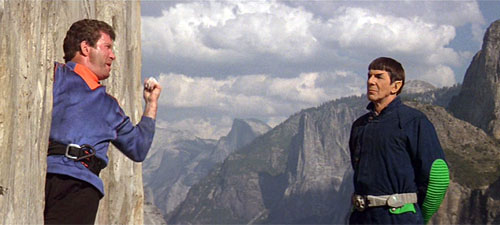 Well, here we are. I actually had to go out to a shop and buy a copy of Star Trek V: The Final Frontier on DVD, otherwise I wouldn’t have been able to write this review. Before making this noble sacrifice, I think I’ve only seen this particular instalment in the movie series twice, once at the original cinematic release, and once on TV. It has the reputation of being the worst of all the Star Trek films, and for good reason.
Well, here we are. I actually had to go out to a shop and buy a copy of Star Trek V: The Final Frontier on DVD, otherwise I wouldn’t have been able to write this review. Before making this noble sacrifice, I think I’ve only seen this particular instalment in the movie series twice, once at the original cinematic release, and once on TV. It has the reputation of being the worst of all the Star Trek films, and for good reason.
It opens in Yosemite Valley, where the Enterprise bridge crew are spending shore leave on a camping trip. Kirk is shown free climbing El Capitan, a feat that by all rights should be physically beyond anyone of William Shatner’s physical condition at the time. He is saved from falling to his death by Spock, in a Chekhov’s-gun-setup use of gravity boots. Kirk says he was never worried, since he’s always known that he will die alone.
On the distant planet Nimbus III, we see a wretched hive town. The Romulan ambassador Caithlin arrives at a seedy bar (complete with a catgirl alien), and explains in excruciating expositionary detail to the human and Klingon ambassadors there that Nimbus III is the “The Planet of Galactic Peace”. The peace is short-lived, as a strange mystical Vulcan and his fanatical followers attack the place and take the ambassadors hostage.
The Enterprise crew are called back to deal with the hostage situation, but the ship is in a mess, despite Scotty working full time on it. Basically anything on the ship that could be broken is broken, for no explicable reason. It’s mind-boggling to think a military vessel not actually in combat would ever be allowed to get into such a state – it really makes no sense at all.
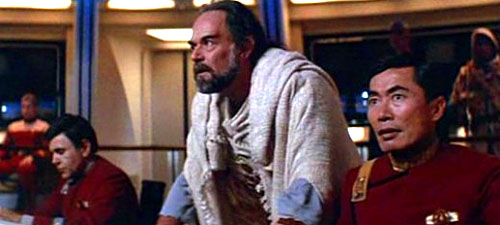 We’re then treated to a shot of a Klingon vessel blowing up an Earth space probe, apparently just for the heck of it. The probe looks remarkably like Voyager, bringing up echoes of V-ger from the first film. The Klingon commander (who is a glam rock star, judging by his hairdo) is ordered to Nimbus as well, and starts salivating at the prospect of destroying Kirk and the Enterprise.
We’re then treated to a shot of a Klingon vessel blowing up an Earth space probe, apparently just for the heck of it. The probe looks remarkably like Voyager, bringing up echoes of V-ger from the first film. The Klingon commander (who is a glam rock star, judging by his hairdo) is ordered to Nimbus as well, and starts salivating at the prospect of destroying Kirk and the Enterprise.
The Enterprise arrives at Nimbus and Kirk decides the best way to approach the city is on space-horses. Nichelle Nichols has to undergo her most embarrassing acting scene ever, as she does a fan dance to distract some nomads so the guys can steal horses and ride into the city. But the ambassador hostages have become followers of the Vulcan, who Spock recognises as the renegade Sybok, and they capture the heroes. Mixed up in a fight scene Spock gives a Vulcan nerve pinch to a horse; apparently their physiology is enough like humanoids that it works on them too.
They take a shuttlecraft back to Enterprise (evading the Klingons mentioned earlier on the way) – the shuttlecraft pickup scene has very strong echoes of the landing scene in Alien. When the shuttle lands on the Enterprise, Spock has a chance to kill Sybok and end the entire crisis, but he refuses to kill his own brother. Wait… Spock has a brother?! Half-brother, it turns out, since Sarek apparently had a Vulcan wife before Amanda – something never before (or after) hinted at in any Star Trek canon. Also wait… why didn’t Spock just set the weapon on stun and shoot Sybok? I guess that particular gun only had a kill setting.
Sybok takes control of the Enterprise and tosses Kirk and Spock in the brig. The toilet in the brig has an obvious sign on it: “Do not use while in space dock”. Presumably somebody on the writing team thought that was funny. Scotty busts them out, after warning them to stand back by tapping on the other side of the brig wall in Morse code. The gravity boots reappear as a way to quickly move up and down the access tubes of the ship.
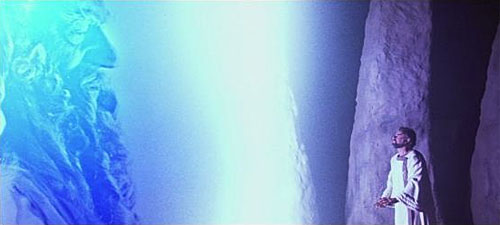 Sybok is taking the ship to the centre of the galaxy, to find the Vulcan legendary world of Sha Ka Ree, where he hopes to find God. They get there and meet a being who looks and sounds like God, and asks to be taken away on their ship to spread his word throughout the galaxy. Kirk asks the only memorable line of the film: “Excuse me, what does God need with a starship?” “God” goes into a rage, Sybok sees through it and sacrifices himself to give the others time to escape. The Klingon ship reappears, but the Klingon ambassador who Kirk and Spock saved arranges for it to fire a torpedo at “God”, killing it. The Enterprise and Klingon vessel part company on peaceful terms, and the heroes head back to Yosemite to finish their camping trip.
Sybok is taking the ship to the centre of the galaxy, to find the Vulcan legendary world of Sha Ka Ree, where he hopes to find God. They get there and meet a being who looks and sounds like God, and asks to be taken away on their ship to spread his word throughout the galaxy. Kirk asks the only memorable line of the film: “Excuse me, what does God need with a starship?” “God” goes into a rage, Sybok sees through it and sacrifices himself to give the others time to escape. The Klingon ship reappears, but the Klingon ambassador who Kirk and Spock saved arranges for it to fire a torpedo at “God”, killing it. The Enterprise and Klingon vessel part company on peaceful terms, and the heroes head back to Yosemite to finish their camping trip.
Whew, I’m glad to have that one over and done with. About the only highlight of the film is Jerry Goldsmith’s music. It opens the film in fine style, with echoes of the original TV series theme, before segueing into the Motion Picture/Next Generation theme, which sounds much more refined and enveloping than in the first film. Throughout the movie, while cringing at what was happening on screen, I was enjoying the music. There are a lot of bad scenes in this film, and the overall story is simply dull and uninspiring. The best moments are the camping sequences that book-end the film, and the scene on the Enterprise where it’s shown to have an old-fashioned sailing-ship-style wheelhouse room, complete with brass and wood ship’s wheel. Now that’s what a starship bridge should look like! If you haven’t seen this film for a long time, like I had, you’re not missing much.
Tropes: Climb, Slip, Hang, Climb, Catch A Falling Star, Not The Fall That Kills You, Chekhov’s Gun, Tricked-Out Shoes, Wretched Hive, Mr Exposition, Cat Girl, Expospeak, ’80s Hair, Horse Of A Different Colour, Show Some Leg, Long Lost Relative, Canon Discontinuity, Everyone Knows Morse, Armour Piercing Question, No Such Thing As Space Jesus, Heroic Sacrifice, Book Ends.
Body count: “God”, Sybok.

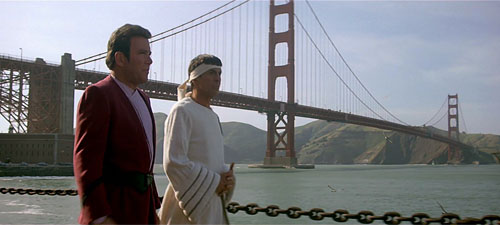 Like the movie before it,
Like the movie before it, 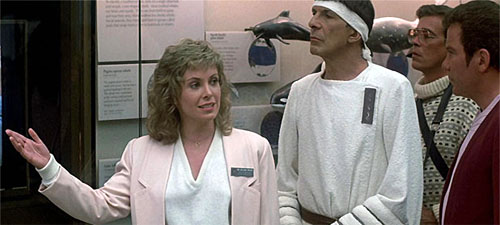 We are treated to some trippy mind-screw hallucinatory images as the Klingon ship slingshots around the sun and is flung back to… 1986! Uhura reports that she is “receiving whalesong!” One wonders how the whales are transmitting it into space – presumably through the same means they use to communicate with the mysterious probe’s civilisation. They land in Golden Gate Park in San Francisco, with the ship cloaked – thus explaining why they had to retain the Klingon ship, since Federation vessels don’t have cloaking technology. Interestingly, in the previous movie, the cloaking device on this same ship produced a rippling effect against the background stars in space that allowed Sulu to see the ship anyway, but now it produces complete and utterly flawless invisibility. Presumably Scotty did some of his magical engineering tweaks on it to improve it.
We are treated to some trippy mind-screw hallucinatory images as the Klingon ship slingshots around the sun and is flung back to… 1986! Uhura reports that she is “receiving whalesong!” One wonders how the whales are transmitting it into space – presumably through the same means they use to communicate with the mysterious probe’s civilisation. They land in Golden Gate Park in San Francisco, with the ship cloaked – thus explaining why they had to retain the Klingon ship, since Federation vessels don’t have cloaking technology. Interestingly, in the previous movie, the cloaking device on this same ship produced a rippling effect against the background stars in space that allowed Sulu to see the ship anyway, but now it produces complete and utterly flawless invisibility. Presumably Scotty did some of his magical engineering tweaks on it to improve it.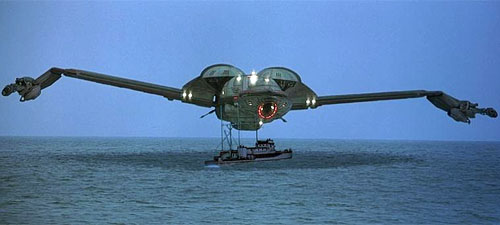 There they release the whales into San Francisco Bay to
There they release the whales into San Francisco Bay to 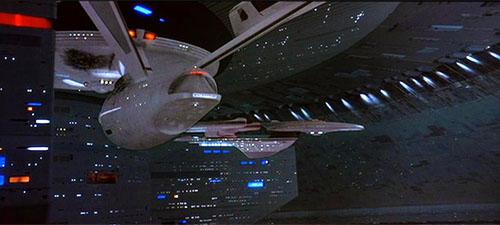
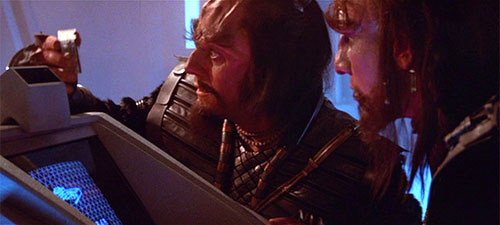 And here’s the plot hole in the film. Kirk appeals to Admiral Morrow to get back Enterprise, but
And here’s the plot hole in the film. Kirk appeals to Admiral Morrow to get back Enterprise, but 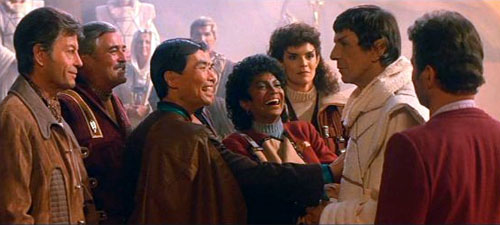 They find the Klingons and Saavik and Spock. Kruge beams down to engage Kirk in a clifftop fistfight, in which Kirk kicks Kruge off the cliff and he
They find the Klingons and Saavik and Spock. Kruge beams down to engage Kirk in a clifftop fistfight, in which Kirk kicks Kruge off the cliff and he 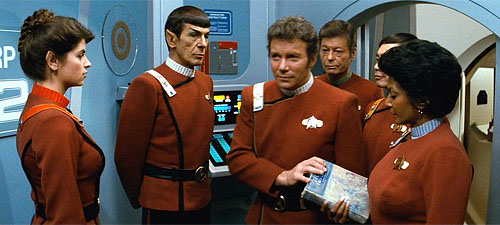 Ah, now here we have something. Star Trek II: The Wrath of Khan is what really drove me to continue this series of reviews into the films. It is widely regarded as the best of the original cast Star Trek films. Watching it again, I am reminded forcefully why this is the case.
Ah, now here we have something. Star Trek II: The Wrath of Khan is what really drove me to continue this series of reviews into the films. It is widely regarded as the best of the original cast Star Trek films. Watching it again, I am reminded forcefully why this is the case.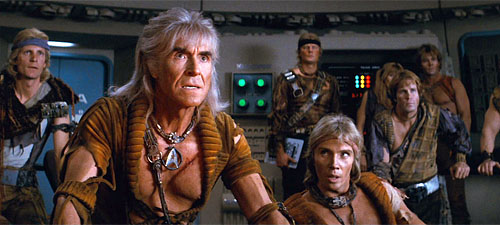 When Kirk arrives at the research station, Khan is ready, and cripples the Enterprise with a pre-emptive attack. Kirk pulls a trick to deactivate Reliant‘s shields and get a shot in, and the two ships withdraw. Kirk, McCoy, and Saavik check the research station and find dead scientists, barely alive Chekov and Terrell, and a transporter recently set to beam inside the nearby asteroid. Spock on board the Enterprise reports the transporters have died and Kirk asks how long until they are repaired. In a transparent piece of
When Kirk arrives at the research station, Khan is ready, and cripples the Enterprise with a pre-emptive attack. Kirk pulls a trick to deactivate Reliant‘s shields and get a shot in, and the two ships withdraw. Kirk, McCoy, and Saavik check the research station and find dead scientists, barely alive Chekov and Terrell, and a transporter recently set to beam inside the nearby asteroid. Spock on board the Enterprise reports the transporters have died and Kirk asks how long until they are repaired. In a transparent piece of 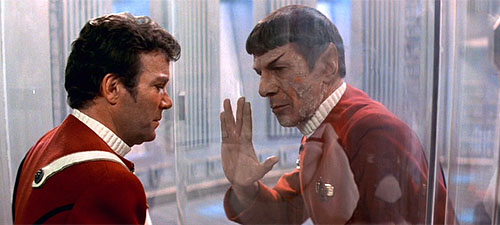 In the denouement, David and Kirk come to terms with their relationship. Then on the bridge, Kirk quotes the ending lines of A Tale of Two Cities, bookending this literary reference to Spock’s sacrifice to save his friends. The final shot is of the Genesis planet, on which we see Spock’s torpedo tube, apparently soft-landed. The famous “Space, the final frontier” speech is then delivered for the first time in the franchise by Leonard Nimoy.
In the denouement, David and Kirk come to terms with their relationship. Then on the bridge, Kirk quotes the ending lines of A Tale of Two Cities, bookending this literary reference to Spock’s sacrifice to save his friends. The final shot is of the Genesis planet, on which we see Spock’s torpedo tube, apparently soft-landed. The famous “Space, the final frontier” speech is then delivered for the first time in the franchise by Leonard Nimoy.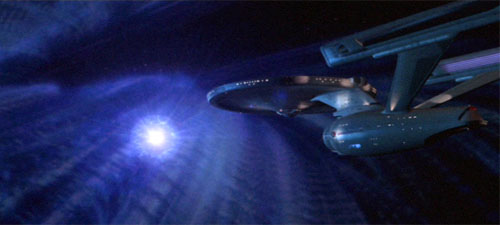 Well that break didn’t last long. I found myself pondering what to watch on a spare Friday evening and my hand drifted to
Well that break didn’t last long. I found myself pondering what to watch on a spare Friday evening and my hand drifted to 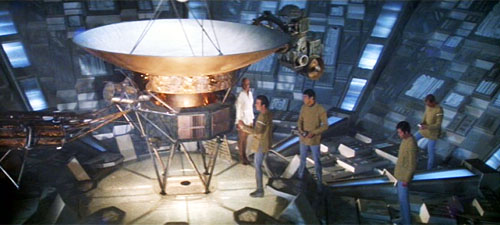 Spock leaves the ship in a space suit to try to meld with the cloud’s mind, and comes back half dead, but with a story about it being perfectly logical, but with no sense of who it is. The cloud is curious and naive. Robo-Ilia
Spock leaves the ship in a space suit to try to meld with the cloud’s mind, and comes back half dead, but with a story about it being perfectly logical, but with no sense of who it is. The cloud is curious and naive. Robo-Ilia 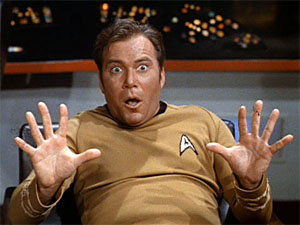 “Turnabout Intruder” is the last episode of Star Trek, and what a dismal ending.
“Turnabout Intruder” is the last episode of Star Trek, and what a dismal ending.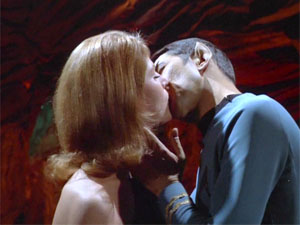 “
“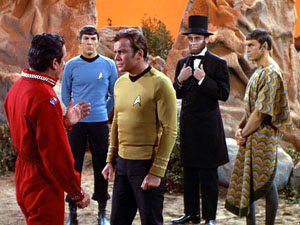 “
“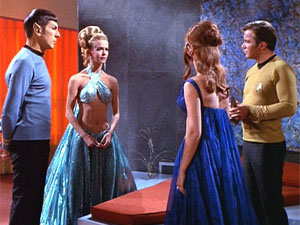 “
“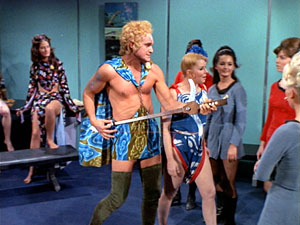 “
“